Despite investing a lot of time and resources into creating quality content consistently, is your content marketing ROI still underwhelming? You’re not alone.
Today content marketing has grown beyond just producing quality content. With over 97% of marketers incorporating content marketing into their marketing strategies and creating thousands of pieces of content daily, it can be challenging to stand out and get results with your content. But it doesn’t have to be.
To thrive and scale in the face of this competition and improve your content marketing team’s functionality and performance, it’s important to build a robust tech stack that helps you scale, without too much stress.
This article will talk about some strategies to scale your content marketing efforts and tools that can help you amplify your results and achieve your goals better.
How to scale your content marketing efforts
Before we dive into the tech stack, let’s see exactly how you can scale your content marketing performance and move the needle towards getting better results on your metrics.
1. Build a high-performing content team
Over 21% of companies lack a dedicated content marketing person or team, without whom it’s impossible to get the desired results. So, building a well-rounded content marketing team with clearly defined roles should be your first priority because it’s this team that will push your efforts forward and helps you get closer to your larger business goals like driving revenue and achieving customer growth or retention.
Every team member will have a separate role and skill set. While some roles may vary depending on your marketing objectives, some are common:
- Managing editor: This is the head of your content team that oversees your editorial calendar, collaborates with the writers and ensures there’s consistency across all pieces of content you produce and it’s aligned with the brand’s messaging. In the larger sense, this person is also responsible for aligning content efforts together and ensuring only top-quality content goes to publishing.
- SEO analyst: This team member is responsible for overseeing SEO requirements and identifying the most effective keywords for each article. They play an important role in guiding each content brief and ensuring each piece of content is rank-ready and driven by search intent.
- Content writer(s): Most content marketing teams either hire in-house writers, outsource the work to freelancers or do a combination of both. Since the center of all content marketing efforts is “content,” these are important people responsible for creating high-quality and research-driven content for your blog, and other content assets.
- Outreach manager: This team member is responsible for distributing your content in the right communities, on websites where your prospects and influencers hang out and build links to ensure you get the most out of each piece of content.
While everyone has a distinct role and responsibility, they’re often brought together by a content marketing manager or executive who governs the entire machinery, facilitates cross-functional collaboration, and ensures each action is corroborated by a larger marketing or business goal to drive results.
Over 21% of companies lack a dedicated content marketing person or team. (Open Link in new window) CLICK TO TWEET(OPEN LINK IN NEW WINDOW)
In smaller startups, it is usually one of the founders who takes on the role of a content marketing manager. Freelance SEO consultants, writers, and virtual assistants can then help execute the content marketing until enough money is earned to fund the team.
2. Create systems to manage the content workflow and team collaboration
Once you have a team in place, define your content workflow and simplify things for your team to collaborate efficiently. A content marketing workflow describes the entire process of actually implementing your content marketing strategy and ensures things flow in a proper framework.
Without this, no one will know whom to report to, what to do next or how results will be measured. This will drop your content marketing efforts and all the time and money you’ve invested down to nothing. We don’t want that, so prioritize building a workflow that ensures work flows logically from one person to another, for example from the writer to the managing editor and the SEO analyst and so on.
You can create Standard Operating Procedures (SOPs) to document each workflow and use tools like ClickUp to put it down in front of you. Create loom videos, and task windows for each team member to follow along, and track their progress on tools rather than “quick” calls.
This illustration from Content Marketing Institute perfectly shows what a sample content workflow should look like.
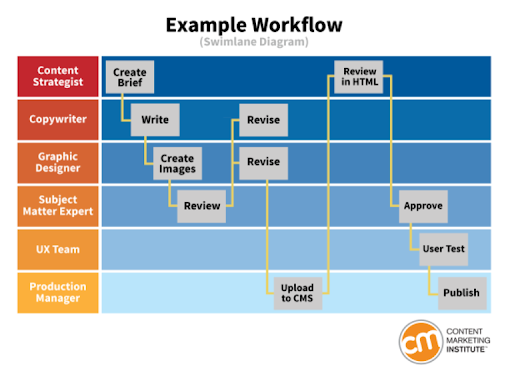
Even if the roles differ slightly from my listing, you get the idea. Overall, ensure you’re creating a well-oiled system. That will help you boost your team’s productivity and efficiency while cutting down time spent on unnecessary back and forth, and confusion. It’s these systems that will make your content marketing strategy stronger, and leakage-proof to get better results.
3. Setup a writing and SEO optimization framework
Your workflow simply defines how content will proceed across the content marketing team, and who will govern the entire scope. But you also need to define the how.
This includes defining how to ideate and vet content topics, what kind of writing guidelines to follow, and how to ensure the content is optimized for the search engine. Also, you want to make sure content is coming from a place of authority so it swims apart from the generic content existing online.
Ideally, this process should include:
Strategizing
Without a content strategy (a part of content marketing), you might just be throwing stuff on the wall, hoping they stick. If you actually want to move in the right direction, and produce content intentionally, per your marketing goals—you need a strategy.
This strategy needs to answer 3 important questions:
- Why: The purpose of the content and its end goal, like a driving awareness
- What: The type of content you plan to create, like blog posts and eBooks and which will help you justify your “why” best.
- Where: Channels where you plan to publish and distribute this content so it reaches the right target audience.
Briefing
No content piece that gets you significant results can be produced without a comprehensive brief in place. So, this stage is about creating a detailed brief for the writer that gives them a detailed overview of the topic, language and tone to be used, stage of the funnel you’re targeting, the target audience specifications, call to action, linking and SEO guidelines among other things.
SEMRush has a content brief template you can steal to start creating it for your writers and assist them in producing high-quality content.
Outlining
Once writers have a brief, they’ll go on to create an outline—a bare-bones structure of the content that’s detailed enough to understand context, but not enough to function as a blog post in itself.
This outline stage is important to ensure the writer is on the same page as the strategist and is headed in the right direction. If not, the strategist, SEO analyst, or even an internal subject matter expert can step in and offer suggestions to ensure the writer develops the content while keeping those notes in mind. This will also significantly reduce the chances of major edits towards the end, which means you can get the published version ready sooner and thus speed up your process.
Writing
This is the most crucial step in the process where the writer dives deep into the topic to address the target audience’s pain points, loop in suggestions from the internal content marketing team, interviews external subject matter experts and produce a stellar piece of content that contributes towards building thought leadership.
Optimizing
Once the content is written, it needs to be optimized for the search engine. Here, it will help to have a publishing SEO checklist in place that ensures you’re not missing out on something important like linking, adding alt text or a meta description and so on.
Here’s a helpful one:
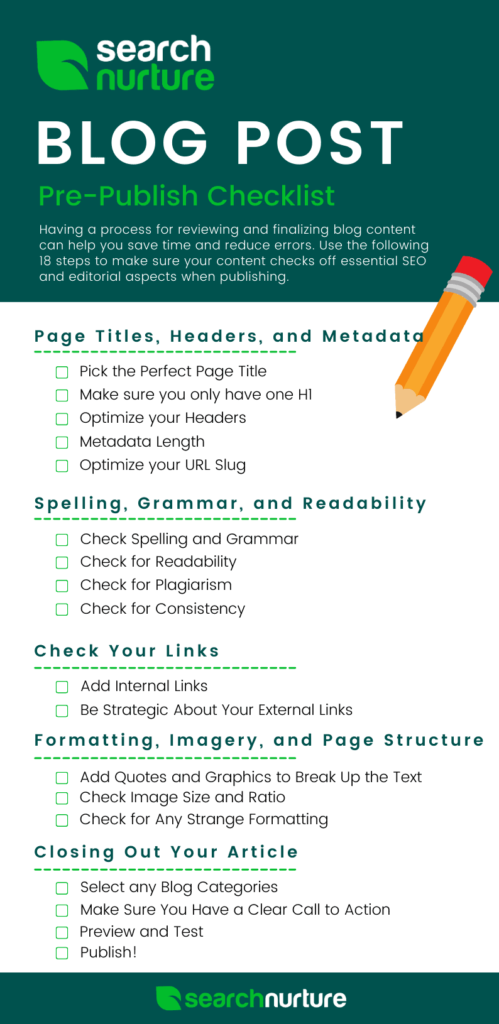
You can also use a content optimization tool like Clearscope to ensure you’re including all essential keywords to move a step further towards ranking higher on the Search Engine Results Page (SERP)
Editing
You can’t ship your content without ensuring all spellings are correct, there are no grammatical errors, or that everything flows logically well in your piece of content. So, this step is about ruthlessly editing the content to make it crisp, concise, highly valuable, skimmable and an authoritative asset on the topic.
4. Content promotion and collaboration
You can’t just create a piece of content, publish it and call it a day.
Unless you promote it through the right channels, it won’t reach the right audience, let alone generate the results you desire.
So, identify the channels where your audience is most active and build a promotion framework to get more eyes to your content. Some channels you can leverage include LinkedIn, Twitter, Instagram, communities, newsletters, and guest posts.
Network with other content marketers and promote each other’s content. You will not only get links to your new blog posts, you will also boost your domain authority at the same time.

Here is an illustration from Orbit Media to illustrate the benefits of collaboration.
5. Content distribution
Content distribution involves publishing, promoting, and sharing your content with your audience across various platforms. The three main content distribution channels are owned, earned, and paid. This Hubspot diagram highlights how you can combine these three channels to distribute your content and get attention from the right kind of people.

Best tools to scale your content marketing process and achieve workflow automation
An inefficient workflow can lead to slower content creation and lower quality of content since your team members will have difficulty collaborating and communicating effectively.
With tools like these, you can assign tasks, monitor workflow progress, and quickly take control of the overall content process. Moreover, they will save your team time and allow them to focus on more meaningful work to grow your business.
1. Google Docs
Google Docs is a writing tool that allows you to write, edit and collaborate on online documents in real-time.
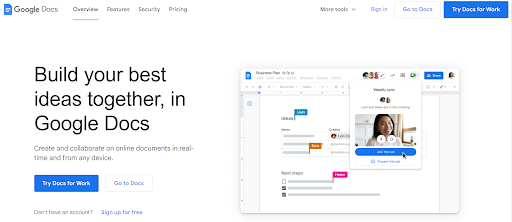
With Google Docs, you can easily share documents with teams and collaborate with them by giving editing access. You can also use their “suggestions,” “comments,” and “@-mentions” features to add relevant people, files, and events to your online Docs—to get an enhanced collaborative experience.
Using assistive features like Smart Compose, voice typing, and document translation, you can write faster with fewer errors, allowing you to focus on your ideas.

Other Articles on Digital Marketing
Free, easy to use, and loaded with features and plugins, this is one of the best tools for editing and collaborating on content pieces and strategies.
2. GatherContent
GatherContent is centralized content creation, production, and collaboration platform that enables more efficient content creation.

GatherContent provides a single platform to create and edit content, track its progress, and publish it. This allows your team to consistently produce structured content at scale and in a fraction of the time.
In GatherContent, you can set up content workflows to ensure your content gets seen at the right time by the right audience. Additionally, you can manage budgets and resources much more effectively, reducing risk in large-scale projects.
This is a perfect tool for those who want to operationalize all the project management features associated with content production.
3. Narrato
Narrato is a content workflow and team management platform that enables you to automate and manage your content production process, as well as facilitate collaboration.

Narrato offers a range of excellent features when it comes to creating content, including AI writing assistants, idea generators, image search, and freelancer management modules. Its project and content management features allow you to organize content using folders, Kanban boards, lists, and calendars.
If you are someone without a strong content marketing team, then Narrato can be your go-to option as it enables you to ideate, plan, create, collaborate and publish content on a single platform.
4. Monday.com
Monday.com is an all-in-one platform with tools for collaboration, content planning, and campaign management.

With Monday.com’s fully customizable templates, you can collaborate more efficiently and plan and manage your content production without any hassle.
You can also easily centralize all your work, processes, tools, and files into one OS with Monday.com, enabling you to scale workflows as your needs evolve.
5. Wordable
Wordable lets you upload Google Docs drafts to WordPress in seconds, fully formatted.

It cleans up your document, removing span and font tags, unnecessary line breaks, and spaces, making it publish-ready with just a click.
In addition, it compresses images, automatically generates compatible tables, simulates featured images, assists in setting alt text and video links, and much more.
If your team works primarily on Google Docs, then Wordable is your go-to tool as it drastically speeds up the process of exporting bulk content as live posts in seconds.
Best tools to scale writing and content optimization
Your content marketing efforts are greatly dependent on the writing process and SEO optimization frameworks you follow, as they determine the quality and reach of your content.
Therefore, it is imperative to employ tools that improve your writing process and aid your SEO efforts.
1. WriterAccess
WriterAccess is a content creation platform for finding freelance talent, ordering content, and simplifying your workflow.

It offers a variety of features such as advanced search, casting calls, and AI-powered style metrics matching, making it easy for you to find the right freelancer. Additionally, WriterAccess has a suite of Partner AI tools so that you can track SERPs, research trending topics, discover popular keywords, and optimize content.
Besides improving your overall writing process, WriterAccess is a tool that allows you to customize your workflow as well.
2. Frase
Frase is an AI-powered tool that identifies your audience’s questions and helps you answer them.
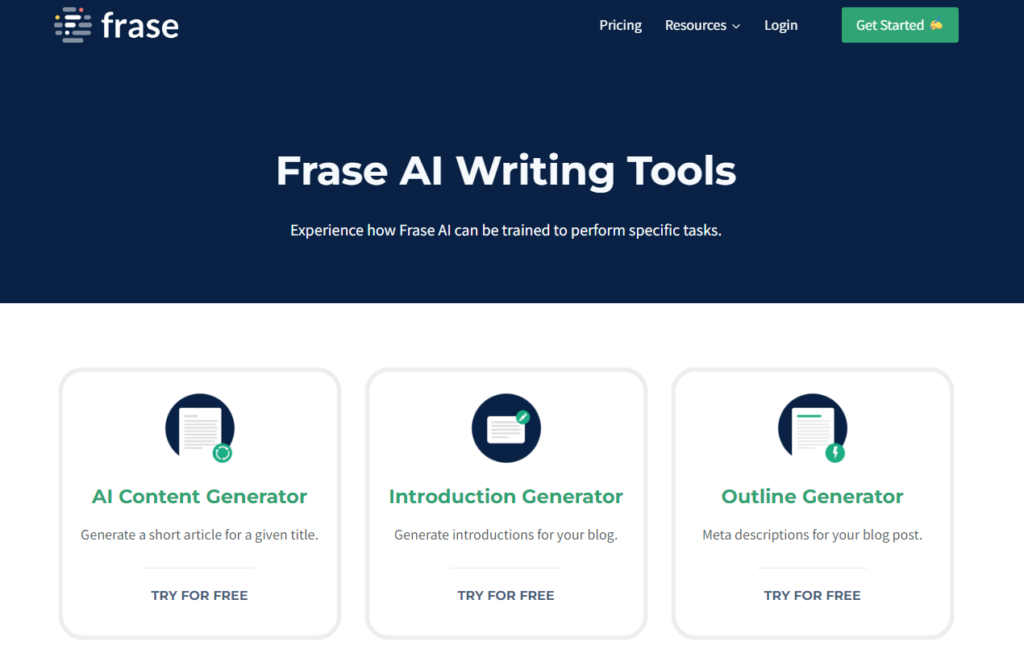
It helps determine the queries your website visitors want to address using Google Search Console. In addition, it generates detailed briefs and enables you to optimize content for articles that people are actually interested in.
All your audience’s questions can be answered in one place, allowing you to position your product also as a solution.
3. MarketMuse
MarketMuse is an AI-powered tool that enables the creation of content strategies, identifying gaps in topics, and expediting the publishing process.
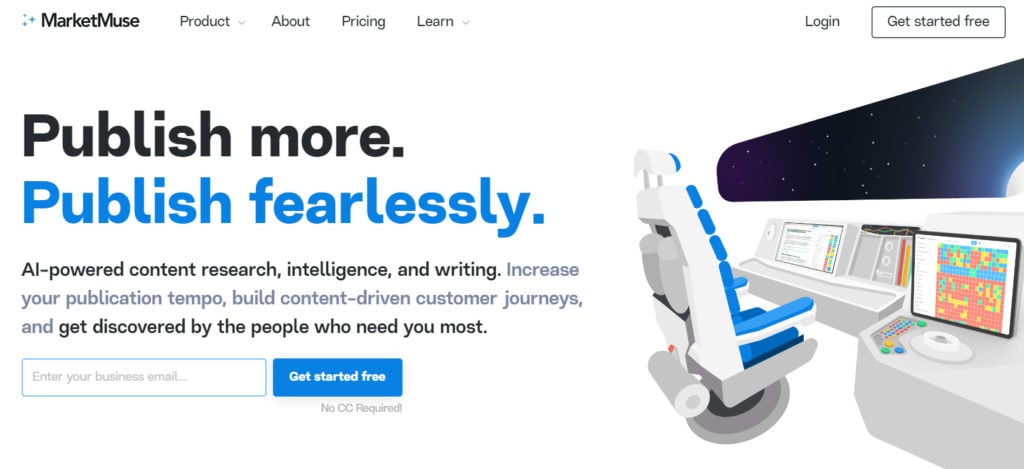
With MarketMuse, you can accelerate your content research, creation, and user optimization processes using artificial intelligence. Furthermore, MarketMuse has various robust methods for creating content-driven customer journeys and optimizing your content for Google search.
This AI-based content marketing and keyword planner allows you to speed up content research, development, and optimization and drastically scale your writing process.
4. Clearscope.io
Clearscope is an AI-driven content marketing and optimization tool that enables you to quickly conduct topic research, develop content briefs, and optimize content.

With Clearscope, you can uncover keyword opportunities and know what words to use in your content piece to perform better organically based on the top-ranking pieces for a particular keyword.
Its user-friendly interface makes it easy for your content team to understand what to write about and how to write it, making your whole content creation process easy and fast.
5. Writesonic
Writesonic is an AI-powered copywriting assistant that helps you create compelling marketing copy in just a few seconds.

The Writesonic tool extends beyond content creation to create clickable titles for your YouTube videos, growth hacks to boost your business, and high-converting landing page copy.
With Writesonic’s AI Writer and Sonic Editor, you can easily create blogs, articles, essays, reports, and even ebooks with just a click. Additionally, you can use our AI-driven editing tools, such as Paraphraser, Expander, and Shortener, to improve your content.
Best tools to scale content promotion and collaboration
Content promotion and collaborations are other vital areas where you can stand out from the crowd and attract your target audience.
For instance, your blog is more likely to be viewed as worthwhile if you host engaging guest posts. It will be easier for people to identify your brand because of the exciting content and expertise that you provide.
The following tools will enable you to connect with these talents and facilitate collaboration.
1. Evaboot.com
The best place to look for collaboration partners is LinkedIn. With Evaboot, you can extract, clean, and find emails from LinkedIn Sales Navigator with one click.
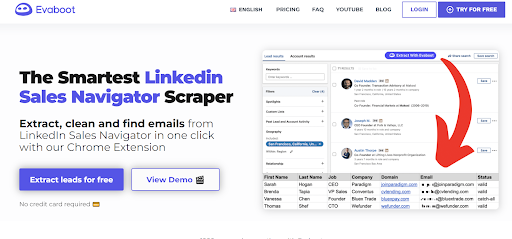
Evaboot makes it easy to find qualified contacts by searching through the biggest business network. This is done with the right filter quality and relevant results to help you connect with those you want to collaborate with.
You can then connect your email finder in one click with its API connector. This will get the mail list of all the people you want to get in touch with. What I personally find so nice about evaboot is that it cleans up the names and removes any additional information (e.g. “Uber LTD” changes to “Uber”) or emoticons. This saves a lot of time and increases the quality. We all know that nobody likes automated messages, so it’s important to be as authentic and individualized as possible when writing to contacts. Plus, the quality of the data plays a major role here.
2. Respona.com
Respona is a link-building tool that automates outreach, creates branded email campaigns, discovers the email addresses of the people you need, and delivers personalized pitches to those contacts.

Respona helps you build high-quality backlinks, raise brand awareness, and explore opportunities to collaborate with other bloggers and websites.
It also enables you to create automatic email sequences that you can use to send personalized pitches to contacts using your email list.
3. Mailshake.com
Automate your cold outreach with Mailshake to engage more prospects and schedule more meetings.

The Mailshake email writer uses artificial intelligence and data from tens of thousands of cold email campaigns to create consistent, high-performing email content, which you can use to cold outreach your leads for collaboration.
Moreover, you can directly communicate with prospects on the phone or on social media through a single dashboard.
4. Hyperise
Hyperise allows you to customize visuals in email campaigns, LinkedIn and Facebook messaging, and chatbots.

This tool allows you to add customization layers to photos generated using Hyperise’s online editor or modify them directly from your website.
You can add dynamic text layers with your prospect’s first and last name, company name, job title, phone number, website, and address. Furthermore, you may use profile pictures, logos, screenshots of websites, pinned map coordinates, and even customized QR codes.
With 74% of marketers claiming that targeted personalization increases engagement, this personalization touch will easily give you an edge over your competitors.
5. Icereach
Icereach lets you contact prospects via LinkedIn using smart automated sequences.

Easily import your leads and personalize the outreach at scale. You can add specific characteristics to write the most unique and individualized message possible. The tool will then send an automatic drip campaign with automated follow-ups.
A special reason why I mention it here is the fact that it assigns you a unique IP from your country and mimics human behavior. So your Linkedin automation flies under the radar and protects you from being banned.
74% of marketers claim targeted personalization increases engagement.(Open Link in new window)CLICK TO TWEET(OPEN LINK IN NEW WINDOW)
Networking on LinkedIn can quickly become overwhelming. Icereach’s easy-to-use dashboards and the ability to switch between different LinkedIn accounts in a flash make managing LinkedIn accounts a breeze.
Best tools to scale content distribution
If you don’t have a proper distribution channel where you can easily reach your audience and showcase your content, then all your effort will be put to waste even after creating killer content.
Therefore, you need tools that will help you publish, share, and promote your content effectively. In this way, you will be able to provide your content across various channels and media platforms for your audience members to consume.
1. IFTTT
IFTTT is a product that allows you to connect, integrate, and automate your favorite apps.

By integrating with over 250 business and personal apps, IFTTT becomes one of the best options to automate your content distribution.
For example, you can set up an automation so that when you share a post on Facebook, it automatically posts to Twitter, Instagram, and other services, if any.
2. Moosend
Moosend is one of the most effective tools that enable you to design professional-looking email newsletters.

With its user-friendly interface and a drag-and-drop editor, this newsletter software not only helps you design email campaigns but also targets your contact list with tailored content.
If you want to create newsletters that convert, Moosend is an excellent option due to its array of responsive email templates and various customization options.
For marketers looking to create newsletters that convert, Moosend is an excellent tool due to its responsive email templates and customization options.
3. Planable
With Planable, you can easily manage your social media content, collaborate with others and schedule it from anywhere.

By scheduling your posts for social media in advance, Planable streamlines the process of social media publishing.
You can also preview your social media posts as if they were live. In this way, you’ll have a better idea of how your posts will appear before they’re published live and can make necessary changes if necessary.
4. Quuu
Quuu is a tool that will help you obtain high-quality recommendations based on your audience’s interests.

Quuu’s content is hand-curated and individually evaluated by a team of knowledgeable content managers to ensure your audience receives the highest quality content.
With over 500 interest categories, you will never run out of content when you use Quuu.
5. Outbrain.com
Outbrain offers marketers personalized recommendations across the world’s top publications to engage with their target audiences.

Using Proprietary Interest and Behavioral Data captures your audiences’ attention and motivates them to take action. Outbrain uses more than 50 algorithms to recommend content to the most interested readers in their network.
With these algorithms, you can prioritize the headlines that are most engaging in your campaign. By determining which content is popular, they can attract new customers to their business.
Conclusion
Content marketing is undoubtedly an excellent way to build brand authority and grow your business—however, many businesses struggle with scaling their content marketing efforts, given the cut-throat competition.
So, we have compiled this list of 20 tools you can use to scale your content marketing efforts, without spreading yourself too thin. You can use these tools to create, distribute, measure, and engage customers, enabling you to take your business to greater heights.
As a reputed Software Solutions Developer we have expertise in providing dedicated remote and outsourced technical resources for software services at very nominal cost. Besides experts in Digital Marketing We also build web solutions, mobile apps and work on system integration, performance enhancement, cloud migrations and big data analytics. Don’t hesitate to Get in touch with us!





